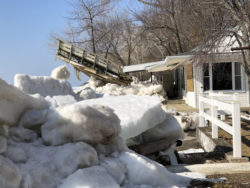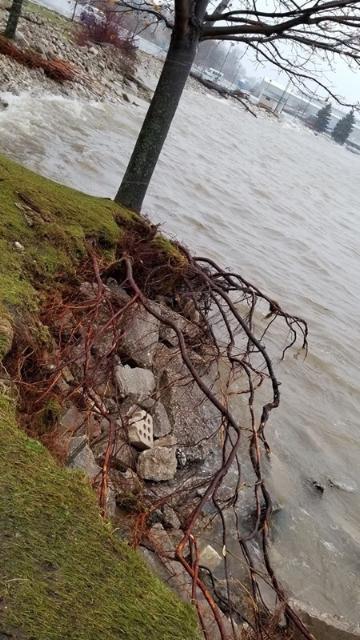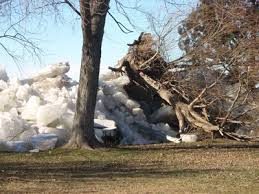WHAT CAUSES SHORELINE EROSION?
Lakeshores are areas of constant dynamic energy. Powerful waves, high water, and ice move soil particles away from shorelines. In more severe cases, small pebbles and eventually rocks begin to wash out. When the water reaches far enough up the shoreline, erosion of lawns and exposing tree roots start.
We’ll try to answer some of your questions today.
What are the leading causes of shoreline erosion?
On open water like Green Bay, the three leading causes of erosions are:
-
- Wave action;
- High water; and
- Ice movement.
The ice on frozen lakes or the Bay can expand towards the shore with a force of many tons per square foot. The ice will destroy most obstacles in its path. Masses of ice put in motion by winds can push trees or buildings over, as exhibited here.
Ice also pushes embankments, uprooting trees and lawns on small inland lakes. No matter how massive a tree is, the ice won’t slow down for it.
In relatively small inland lakes, breaking waves can erode lawns away.
Headlands (points) usually have relatively high erosion rates. The waves, currents, and the ice will attack from all three sides. These attacks eventually transport the sediments to a new location where they settle in calmer weather.
Erosion is a normal process of nature.
Erosion and the redistribution of sediments is a natural process along shorelines. Typically, natural erosion proceeds very slowly. The plants and animals that live along the shore can adjust to these slow changes. They maintain a stable, healthy, productive ecosystem.
Accelerated erosion results when natural or human disturbances cause this equilibrium to be upset. Examples of this are higher than normal water levels and intense storms.
Human disturbances include vegetation removal, dredging, filling, or construction near the shoreline.
Another example of natural disturbances is large trees uprooted by a windstorm or a flood. When the soil becomes saturated with water, it weakens the soil around tree roots. The winds may uproot that tree.
IDENTIFY SERIOUS EROSION PROBLEMS
These are several signs of severe erosion problems. (Number one and three are significant)
- A large area of bare soil on a steep, high shoreline bank;
- A measurable change of the shoreline over time;
- Leaning or downed trees with exposed roots; and
- Large patches of muddy water near a lakeshore during periods of high water or following a rainstorm.
3 TYPES OF REACTIVE EROSION CONTROL METHODS:
Vegetative/No Mow: This method involves encouraging or planting trees or woody shrubs for the soil binding properties of their root systems. Grass and other plants will protect against raindrop impact and scouring from surface runoff.
Structural: This includes protective structures. The placement of rock of various sizes (rip-rap) has traditionally been the most effective and least expensive method.
Other structural methods include bulkheads, gabions (rock-filled baskets), and railroad ties. However, these methods are visually unappealing. They require more heavy equipment and technical expertise. These systems are more prone to failure than simple rip-rap. In addition, the DNR has disapproved of these methods in the past.
Manipulative: Mostly used on streams, this includes:
-
-
- Removing streamflow obstructions;
- Grading shoreline banks, or, in exceptional circumstances;
- Rerouting a stream channel.
-
Are there new techniques developed to prevent erosion?
A new soil preservation method called bioengineering has been proven successful.
Soil bioengineering combines mechanical, biological, and ecological concepts. These methods arrest and prevent shoreline erosion. An example is planting willows interspersed with rip-rap, where the rock provides immediate resistance to decay.
As the willows become established, roots invade and permeate the rock and underlying soil. They bind them together into an erosion-resistant mass. The willows also impart a more “natural” look to the shoreline.
Water levels are down; I don’t have to worry – Right??
This year, people do see water levels about 18-24″ less than in 2020. High water levels are the most significant contributing factor to shoreline erosion.
Will it stay down next year or in the years after? No one knows. In Las Vegas, that’s called a crapshoot.
What other factors affect my shoreline?
The next factor is the intensity of the storms. The Door County Peninsula had numerous high wind storms this year with up to 70 MPH winds.
A popular Marina in Sturgeon Bay: Skipper Bud’s Harbor Marina, located at the foot of the Michigan St. bridge, was a victim of a recent storm.
The marina had two of its five floating docks torn loose during a strong storm. Two tub boats quickly moved in place to prevent them from swinging into the bridge.
Are there other contributing factors to shoreline erosion?
You can expect water levels to rise rapidly when winds blow from the NW – NE direction for prolonged periods. This is despite the lower water levels this year. The stronger the winds, the higher the water will go. Waters south of Sturgeon Bay are particularly affected by these winds. In those areas, there are no other large outlets for the water to escape.
DO YOU NEED AN ESTIMATE FOR RIP-RAP?
Contact Dave@ 920-493-4406 or email at Dave@wisconsinpws.com.
What comes next?
Next week (on Aug 10, 2021), we will cover:
-
-
-
-
- Planning an erosion control project;
- Does erosion hurt my property values?
- What to expect for the cost of rip-rap.
-
-
-
Where is Pier & Waterfront Solutions?
Located at 7325 St. Hwy 57, it’s 3 miles south of Sturgeon Bay and 1 mile past the intersection of Cty MM (heading north). Look on the right side, one mile north, at the next corner (Idlewild Road and Hwy 57).
Is PWS OPEN?
The “Delta” variant is currently surging across the country.
Pier & Waterfront Solutions remains “open.” We have implemented measures to help protect the safety of our employees and visitors. PWS continues to work to maintain the trusted service that you have come to expect.
PWS implemented these preventive measures:
- Conducting as much business as possible by email, text, or phone.
- Site visits will continue.
- When in-person contacts are necessary, we follow “social distancing” guidelines.
- Our display yard is always open for you to examine at your leisure.
- All displays have a numbered, red tag on them. For more information, please reference that number.
What can YOU do to help us?
1. Conduct as much business as possible via emails, messaging, and emails.
2. When you see our crews installing equipment, please practice “social distancing.”
Thank you for allowing us to work with you.
YES – PWS is OPEN and waiting for you!
Please call, message, or email PWS with any questions.
Let’s all stay safe!








